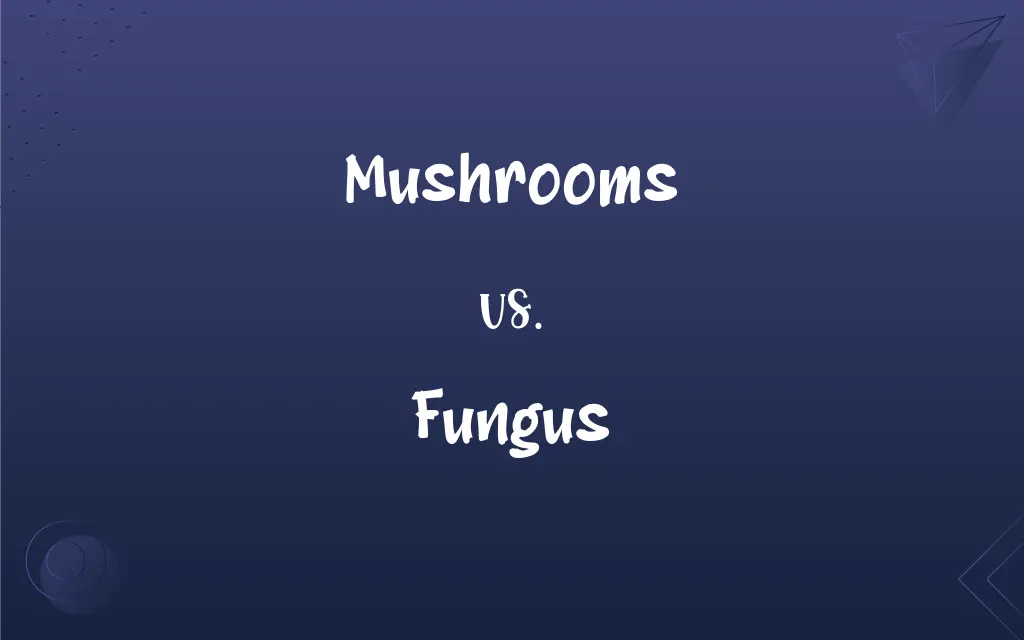Mushrooms vs. Fungus: What's the Difference?
Edited by Aimie Carlson || By Janet White || Published on April 17, 2024
Mushrooms are the fruiting bodies of some fungi, visible above ground, while "fungus" refers to the entire group of eukaryotic organisms, including molds, yeast, and mushrooms.

Key Differences
Mushrooms and fungus are terms often used interchangeably, yet they represent distinct concepts within the biological kingdom of fungi. Mushrooms are the reproductive structures produced by some types of fungi, recognizable by their cap, stem, and gills. They serve as the fruiting body through which the fungus reproduces, releasing spores into the environment. Fungus, however, encompasses a much broader category of organisms, including not only mushrooms but also molds, yeasts, and rusts, each with unique characteristics and life cycles.
Mushrooms are a familiar sight to many, appearing as umbrella-shaped bodies in forests and fields, they are merely the visible part of a larger fungal organism. The bulk of a fungal organism exists underground or within its substrate as a network of hyphae, known as mycelium. This mycelial network is responsible for nutrient absorption and can span vast areas, unseen by the naked eye. Fungus as a whole functions within ecosystems as decomposers, recyclers of organic material, and symbiotic partners with plants and animals.
Mushrooms play a crucial role in the reproduction of their fungal species, emerging under suitable environmental conditions to spread spores. These spores, carried by wind, water, or animals, lead to the proliferation of the fungus in new locations. Fungus, in its broader sense, impacts various aspects of human life, from the decomposition process essential for nutrient cycling to their use in medicine, food, and biotechnology. Their diverse forms and functions highlight the complexity of the fungal kingdom beyond what is visible as mushrooms.
Understanding the distinction between mushrooms and fungus is vital for both ecological studies and practical applications. Mushrooms are sought after for their nutritional and medicinal properties, with certain species highly prized as delicacies. Conversely, understanding fungus in its entirety is crucial for managing plant diseases, developing antibiotics, and harnessing fungal enzymes for industrial processes. The study of fungi, mycology, encompasses this wide range of organisms, exploring their roles in ecosystems, their benefits, and sometimes their dangers to humans and crops.
Mushrooms represent just one manifestation of the diverse and intricate world of fungi. While mushrooms are the fruiting bodies through which some fungi reproduce, the term "fungus" covers a vast kingdom of organisms with critical roles in natural and human-influenced environments. The relationship between mushrooms and the broader category of fungus underscores the complexity and importance of these organisms in the Earth's ecosystems.
ADVERTISEMENT
Comparison Chart
Definition
The fruiting body of certain fungi, visible above ground.
A kingdom of spore-producing organisms including molds, yeast, and mushrooms.
Role in Lifecycle
Reproductive structure for spore dispersal.
The entire organism, with roles varying from decomposer to symbiont.
Visibility
Typically visible to the naked eye when mature.
Often microscopic, except for parts like mushrooms or large mold colonies.
Ecological Function
Primarily involved in reproduction.
Decomposition, nutrient recycling, symbiosis, and sometimes pathogenic.
Types
Varieties include button, shiitake, and morel mushrooms.
Includes diverse forms such as rusts, smuts, molds, and mushrooms.
ADVERTISEMENT
Mushrooms and Fungus Definitions
Mushrooms
Appear seasonally, often after rain.
After a rainy week, mushrooms sprouted across the forest floor.
Fungus
Can be pathogenic to plants and animals.
The white-nose syndrome in bats is caused by a pathogenic fungus.
Mushrooms
Can be cultivated or wild-harvested.
Portobello mushrooms are commonly cultivated for their large size and meaty texture.
Fungus
Encompasses a kingdom of diverse organisms.
Penicillium, a type of fungus, is used to produce the antibiotic penicillin.
Mushrooms
Edible fungi prized for their flavor.
Shiitake mushrooms are a popular ingredient in Asian cuisine.
Fungus
Some fungi form symbiotic relationships with plants.
Mycorrhizal fungi enhance plant nutrient uptake through their root systems.
Mushrooms
Some species are known for medicinal properties.
Reishi mushrooms are used in traditional medicine for their health benefits.
Fungus
Essential for ecosystem nutrient cycling.
Fungus decomposes dead wood, returning nutrients to the soil.
Mushrooms
Identification requires caution due to toxic varieties.
It's crucial to correctly identify mushrooms, as some lookalikes are poisonous.
Fungus
Includes yeasts used in baking and brewing.
Saccharomyces cerevisiae, a yeast fungus, is vital for making bread and beer.
Mushrooms
Any of various fungi that produce a fleshy fruiting body, especially one consisting of a stalk with an umbrella-shaped cap.
Fungus
Any of numerous spore-producing eukaryotic organisms of the kingdom Fungi, which lack chlorophyll and vascular tissue and range in form from a single cell to a mass of branched filamentous hyphae that often produce specialized fruiting bodies. The kingdom includes the yeasts, smuts, rusts, mushrooms, and many molds, excluding the slime molds and the water molds.
Mushrooms
Any of such fungi that are edible, especially the widely cultivated species Agaricus bisporus, which includes the button, cremini, and portobello mushrooms.
Fungus
(mycology) Any member of the kingdom Fungi; a eukaryotic organism typically having chitin cell walls but no chlorophyll or plastids. Fungi may be unicellular or multicellular.
Fungus
A spongy, abnormal excrescence, such as excessive granulation tissue formed in a wound.
Fungus
Any one of the Fungi, a large and very complex group of thallophytes of low organization, - the molds, mildews, rusts, smuts, mushrooms, toadstools, puff balls, and the allies of each. See fungi.
Fungus
A spongy, morbid growth or granulation in animal bodies, as the proud flesh of wounds.
Fungus
A parasitic plant lacking chlorophyll and leaves and true stems and roots and reproducing by spores
FAQs
How do mushrooms relate to fungus?
Mushrooms are a part of the fungal life cycle, serving as the reproductive structure for some fungi.
Can mushrooms be eaten?
Many mushrooms are edible, but identification is crucial as some are toxic.
What constitutes fungus?
Fungus refers to a kingdom of spore-producing organisms, including molds, yeast, and mushrooms.
What are some common uses of fungi?
Fungi are used in food production, medicine (e.g., antibiotics), and biotechnology.
What role do fungi play in nature?
Fungi play diverse roles, from decomposers breaking down organic material to forming symbiotic relationships with plants.
What is a mushroom?
A mushroom is the fruiting body of certain fungi, visible above ground and involved in spore dispersal.
What distinguishes toxic from edible mushrooms?
Toxic and edible mushrooms can differ in features like color, shape, and habitat, but expert knowledge is often required for safe identification.
How can you safely identify edible mushrooms?
Safe identification requires knowledge, experience, and sometimes consultation with experts or field guides.
Why are some fungi considered pests?
Some fungi are pathogenic to plants and animals, causing diseases that can lead to significant damage or death.
How do fungi contribute to medical research?
Fungi contribute to medical research in antibiotic production, disease studies, and as models for understanding cellular processes.
Are all fungi mushrooms?
No, not all fungi are mushrooms; mushrooms represent just one form of fungi.
How do mushrooms reproduce?
Mushrooms reproduce by releasing spores from their gills or pores, which then grow into new fungal organisms.
Can mushrooms be grown at home?
Yes, many people cultivate mushrooms at home using kits or controlled environments.
What is mycology?
Mycology is the scientific study of fungi, including their genetics, biochemistry, and ecological roles.
How do fungi affect food spoilage?
Some fungi, like molds, can spoil food by breaking down and consuming nutrients, often visible as fuzzy growths on food surfaces.
What is a fungal infection?
A fungal infection occurs when pathogenic fungi invade and grow in or on the body, sometimes causing illness.
What are some challenges in fungal conservation?
Challenges include habitat loss, pollution, climate change, and the difficulty of cataloging and studying diverse fungal species.
Are fungi considered plants?
No, fungi are not plants; they form their own kingdom separate from plants, animals, and bacteria.
How do fungi interact with other organisms?
Fungi interact with other organisms in various ways, from symbiotic relationships that benefit both parties to parasitic relationships that harm the host.
Can fungi be used in bioremediation?
Yes, some fungi are used in bioremediation to break down or remove pollutants from the environment.
About Author
Written by
Janet WhiteJanet White has been an esteemed writer and blogger for Difference Wiki. Holding a Master's degree in Science and Medical Journalism from the prestigious Boston University, she has consistently demonstrated her expertise and passion for her field. When she's not immersed in her work, Janet relishes her time exercising, delving into a good book, and cherishing moments with friends and family.
Edited by
Aimie CarlsonAimie Carlson, holding a master's degree in English literature, is a fervent English language enthusiast. She lends her writing talents to Difference Wiki, a prominent website that specializes in comparisons, offering readers insightful analyses that both captivate and inform.































































